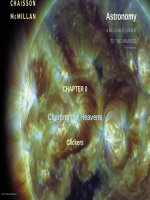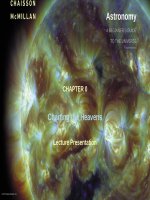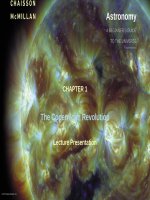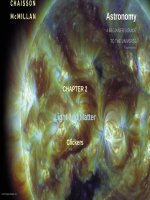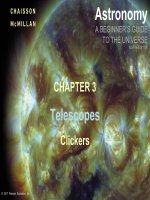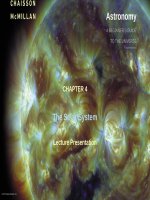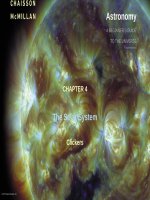Astronomy a beginners guide to the universe 8th CHaisson mcmillan chapter 05
Bạn đang xem bản rút gọn của tài liệu. Xem và tải ngay bản đầy đủ của tài liệu tại đây (4.32 MB, 38 trang )
Astronomy
A BEGINNER’S GUIDE
TO THE UNIVERSE
EIGHTH EDITION
CHAPTER 5
Earth and Its Moon
Lecture Presentation
© 2017 Pearson Education, Inc.
Chapter 5 Earth and Its Moon
© 2017 Pearson Education, Inc.
Units of Chapter 5
•
•
•
•
•
•
•
•
•
Earth and the Moon in Bulk
The Tides
Atmospheres
Internal Structure of Earth and the Moon
Surface Activity on Earth
The Surface of the Moon
Magnetospheres
History of the Earth–Moon System
Summary of Chapter 5
© 2017 Pearson Education, Inc.
5.1 Earth and the Moon in Bulk
© 2017 Pearson Education, Inc.
5.2 The Tides
•
Tides are due to
gravitational force
on Earth from the
Moon; the force on
near side of Earth
is greater than
force on far side.
Water can flow
freely in response.
© 2017 Pearson Education, Inc.
5.2 The Tides
•
The Sun has less effect, but it does
modify the lunar tides.
© 2017 Pearson Education, Inc.
5.2 The Tides
•
•
Tides tend to exert a “drag” force on Earth, slowing its rotation.
This will continue until Earth rotates synchronously with the Moon so that the same side of
Earth always points toward the Moon.
© 2017 Pearson Education, Inc.
5.2 The Tides
•
This has already happened with the Moon, whose near side is always toward Earth.
© 2017 Pearson Education, Inc.
5.3 Atmospheres
•
The blue curve shows the
temperature at each altitude.
•
Troposphere is where convection
takes place. It is responsible for
weather.
© 2017 Pearson Education, Inc.
5.3 Atmospheres
•
Convection depends on warming of the ground by the Sun.
© 2017 Pearson Education, Inc.
5.3 Atmospheres
•
Ionosphere is ionized by solar
radiation and is good conductor.
•
It reflects radio waves in the AM
range, but it is transparent to FM
and TV.
•
Ozone layer absorbs ultraviolet
radiation.
© 2017 Pearson Education, Inc.
Discovery 5.1: Earth’s Growing Ozone Hole
•
Chlorofluorocarbons (CFCs) have been damaging the ozone layer, resulting in an ozone
hole.
© 2017 Pearson Education, Inc.
5.3 Atmospheres
•
Surface heating:
–
–
–
Sunlight that is not reflected is absorbed by Earth’s surface, warming it.
Surface reradiates as infrared thermal radiation.
Atmosphere absorbs some infrared, causing further heating.
© 2017 Pearson Education, Inc.
5.3 Atmospheres
•
This is known as the greenhouse effect.
© 2017 Pearson Education, Inc.
Discovery 5.2: The Greenhouse Effect and Global Warming
•
There is extremely strong evidence that Earth is getting warmer. The cause of this
warming is a subject of intense debate; many scientists believe it is related to the
corresponding increase in atmospheric carbon dioxide.
© 2017 Pearson Education, Inc.
5.4 Internal Structure of Earth and the Moon
•
Seismic waves:
–
–
–
–
Earthquakes produce both pressure and shear waves.
Pressure waves will travel through both liquids and solids.
Shear waves will not travel through liquids, as liquids do not resist shear forces.
Wave speed depends on density of material.
© 2017 Pearson Education, Inc.
5.4 Internal Structure of Earth and the Moon
•
The pressure wave
is a longitudinal
wave, whereas the
shear wave is a
transverse wave.
A shear wave
cannot propagate
within a liquid.
© 2017 Pearson Education, Inc.
5.4 Internal Structure of Earth and the Moon
•
We can use the pattern of waves measured by seismometers during earthquakes to
deduce the interior structure of Earth.
© 2017 Pearson Education, Inc.
5.4 Internal Structure of Earth and the Moon
•
Currently accepted model
© 2017 Pearson Education, Inc.
5.4 Internal Structure of Earth and the Moon
•
•
•
•
Mantle is much less dense than core.
Mantle is rocky; core is metallic, consisting of iron and nickel.
Outer core is liquid; inner core is solid, due to pressure.
Volcanic lava comes from mantle, allowing analysis of the mantle’s composition.
© 2017 Pearson Education, Inc.
5.5 Surface Activity on Earth
•
Continental drift: Earth’s entire surface is covered with crustal plates, which can move
independently. At plate boundaries, earthquakes and volcanoes
can occur.
© 2017 Pearson Education, Inc.
5.5 Surface Activity on Earth
•
Plates moving away from each other create rifts.
© 2017 Pearson Education, Inc.
5.5 Surface Activity on Earth
•
If we follow the continental drift backward, the continents merge into one, called Pangaea.
© 2017 Pearson Education, Inc.
5.6 The Surface of the Moon
•
The Moon has large dark flat areas, called maria (early observers thought they were
oceans), due to lava flow.
© 2017 Pearson Education, Inc.
5.6 The Surface of the Moon
•
The far side of the Moon is heavily cratered but contains few maria.
© 2017 Pearson Education, Inc.
